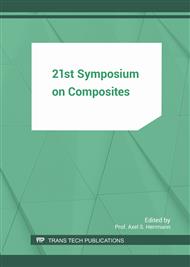[1]
R.M.J.S. Sidhu, R.C. Averill, M. Riaz, F. Pourboghrat, Finite element analysis of textile composite preform stamping, Composite Structures, 52 (3-4), 2011, pp.483-497.
DOI: 10.1016/s0263-8223(01)00038-1
Google Scholar
[2]
B. Engel, J. Graef, Different material models for intra-ply shear and double-dome FE forming analysis, JEC Composites Magazine, No 101, (2015).
Google Scholar
[3]
B. Engel, J. Graef, Influencing factors on the reproducibility of bias extension tests of fiber reinforced thermoplastics, Materials Science and Engineering, September, Darmstadt, 2016, Poster presentation.
Google Scholar
[4]
J Launay, G Hivet, AV Duong, P Boisse, Experimental analysis of the influence of tensions on in plane shear behavior of woven composite reinforcements, Composites Science and Technology, 68, (2008), 506–515.
DOI: 10.1016/j.compscitech.2007.06.021
Google Scholar
[5]
© Dassault Systèmes, Abaqus Analysis User's Manual, (2012).
Google Scholar
[6]
M. Nishi, T. Hirashima, T. Kurashiki, Textile composite reinforcement forming analysis considering out-of-plane bending stiffness and tension dependent in-plane shear behavior. Proceedings of the 16th European Conference On Composite Materials, Seville, Spain, (2014).
Google Scholar
[7]
B. Engel, J. Graef, Study of the bending stiffness of fibre-reinforced thermoplastics at forming temperature, JEC Composites Magazine, No 102, (2016).
Google Scholar
[8]
P. Boisse, N. Hamila, E. Guzman-Maldonado, A. Madeo, G. Hivet, F. Dell´Isola, The bias-extension test for the analysis of in-plane shear properties of textile composite reinforcements and prepregs: a review, International Journal of Materials Forming, 2016, 20p. <10. 1007/s12289-016-1294-7>. <hal-01313827>.
DOI: 10.1007/s12289-016-1294-7
Google Scholar
[9]
R.H.W. ten Thije, R. Akkerman, Intra-ply shear locking, 10th ESAFORM Conference on Material Forming, 18-20 April, 2007, Zaragoza, Spain, (pp.1017-1022).
DOI: 10.1063/1.2729647
Google Scholar
[10]
D. Dörr, T. Joppich, F. Schirmaier, T. Mosthaf, L. Kärger, F. Henning, Sensitivity of material properties on wrinkling behavior and fiber reorientation of thermoplastic UD-Tape laminates during forming analyzed by Finite Element forming simulation, ECCM 17th – 17th European Conference on Composite Materials, 26-30th June, 2016, Munich, Germany.
DOI: 10.1063/1.4963567
Google Scholar
[11]
M. Nishi and T. Hirashima, Approach for dry textile composite forming simulation, Proceedings of 19th International Conference on Composite materials (ICCM-19), 2013, Montreal, Canada, pp.7486-7493.
Google Scholar
[12]
P. Boisse, N. Hamila, E. Vidal-Sallé, F. Dumont, Simulation of wrinkling during textile composite reinforcement forming. Influence of tensile, in-plane shear and bending stiffnesses, Composites Science and Technology, 71 (5), 2011, pp.683-692.
DOI: 10.1016/j.compscitech.2011.01.011
Google Scholar
[13]
Forming Benchmark, Forming of a Double Dome, 2005, http: /www. wovencomposites. org.
Google Scholar


